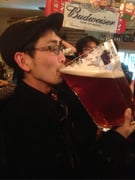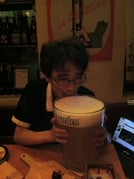Edit
Hoegaarden (pronounced “who garden”) is a Belgian witbier named after a small town in the Flemish region of Belgium that is famous for the rebirth of the Belgian white (“wit”) style of beer. During the 1950s Tomsin, the last white beer brewery in Hoegaarden, closed. The local milkman, Pierre Celis, had worked at the Tomsin brewery as a young man. In 1965, while in his forties, Celis decided to purchase some brewing equipment and start making white beer again. He recreated the recipe based on his experience working at the brewery and from locals who remembered the look and taste of the beer. His new brewery was called De Kluis, meaning “cloister,” in honor of the monks who brewed beer in the region during the Middle Ages. The beer was called Hoegaarden, after Celis’ hometown.
Sold in dozens of countries worldwide, Hoegaarden is widely considered the standard of the Belgian-white style of beer. It is made from malted barley, unmalted wheat, hops, coriander, and curaçao orange peel. It is very pale in color and hazy with a frothy head of foam. The aroma and taste are citrusy, fruity, spicy, and refreshing, with a light snappy bitterness. The beer is light-bodied, well balanced, and mild in strength and balanced with a deceptively mild amount of alcohol (4.9% ABV).
Hoegaarden quickly became successful in Belgium and elsewhere around the world. By 1985 the brewery was producing 75,000 hectoliters of beer per year, when disaster struck and the brewery burned to the ground. Unable to rebuild on his own, Celis turned to the Belgian brewing group Interbrew (now AB-InBev), who eventually ended up owning the brewery and brand.
Types of Hoegaarden beer.
Rosée.
Launched in 2007, 3% ABV. Available in the Benelux.
Citron.
Launched in 2008, 3% ABV.
Grand Cru.
Launched in 1985, 8.5% ABV.
Julius.
An 8.8% blonde ale, with a dry taste formed through triple-hopping.
Forbidden fruit.
(French: Fruit Defendu. Flemish: Verboden Vrucht) An 8.5% dark ale, with complex spicing.
Spéciale.
Launched in 1995, 5.7% ABV. Hoegaarden Spéciale is a full-bodied, rich Belgian-style wheat beer, available from October to January.




